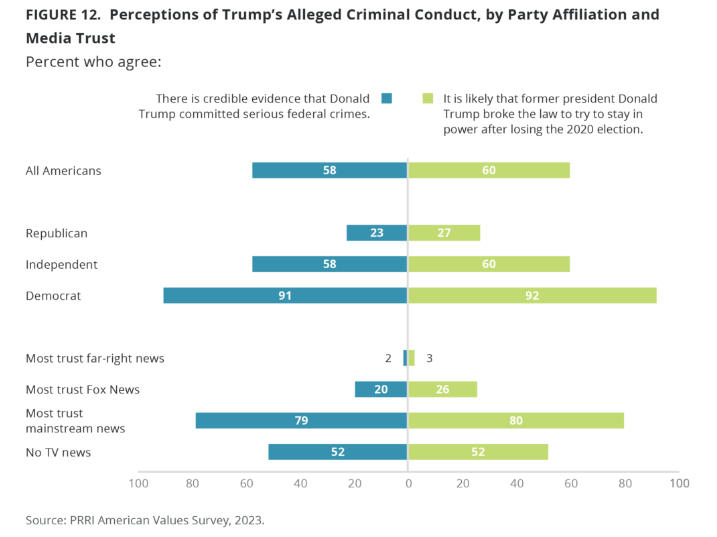
Do you ever wonder how accurate and impartial your news sources are? Do you view yourself as fully informed on all sides? Or are you caught inside an “echo chamber” or “filter bubble” that reinforces your preexisting beliefs and insulates you from conflicting information?
Social scientists tell us that “confirmation bias” is alive and well in most of us. We’re hard-wired to seek, prefer, and remember information that validates our prior beliefs and values. As a consequence, virtually every one of us has an echo chamber. Some are just more extreme and limiting than others.
In this article we’ll explore why it’s important that all Americans take time to understand and manage their echo chambers. We’ll go through the steps for “auditing” your echo chamber and making improvements. In so doing, we can help overcome the growing division and anger that threatens our country.
Why is it so important for me and all other Americans to audit our echo chambers?
Research on echo chambers reveals that they can increase social and political polarization and extremism. After all, if different news outlets emphasize different facts, with different degrees of editorial and opinion commentary, people are going to come away differentially informed.
Perhaps the best way to illustrate the huge impact of echo chambers is to take a real-life example. Below I display a graph from a recent survey asking respondents whether Trump broke the law, including while trying to stay in office. What’s important is that the responses are broken down in terms of the news sources that were trusted by respondents.

On the basis of political party affiliation, it’s not surprising that only 23% and 27% of Republicans believed there was credible evidence that Trump committed crimes or that it was likely he broke the law trying to stay in power. The numbers for Democrats are 91% and 92%, respectively. But when we look at responses from those who most trust far-right news (e.g., OAN or Newsmax), only 2% and 3% respectively saw criminality. As to respondents that most trust Fox News, the numbers were 20% and 26% respectively. On the other hand, respondents who most trust mainstream news saw criminality at 79% and 80% respectively. Clearly, responses varied considerably based on the news source that respondents trusted.
These findings are even more remarkable when we consider that the vast majority of Americans don’t operate in perfectly sealed off echo chambers that they themselves have deliberately curated. Rather, most Americans don’t closely follow politics and make at least some attempt to get information from different sides. Newer research suggests that most of us operate in “epistemic bubbles” where important sources of information have been excluded, often unintentionally. In addition, our news feeds often contain radical and one-sided information sent to us via algorithms. In essence, most of us may not be aware of the extent to which we in an echo chamber.
Yes, we choose the news we watch on television as well as the newspapers and magazines we subscribe to. But in this age, 62% of Americans get their news from social media platforms. And our feeds are replete with political information and news designed to influence and radicalize us.
Most of us simply aren’t fully aware of our echo chambers. We don’t really know how accurate, complete, and unbiased our chosen sources are. The same can be said of articles and posts that show up in our social media feeds. Yes, we certainly have impressions that content may be radical, one-sided, or inaccurate. But what we really need to do is find a way to systematically and objectively evaluate these sources so that we can manage and improve our echo chambers.
There is a way, and I call it an “audit” of your echo chamber. Here are the four steps.
Step one: Make a list of all the news sources you regularly access and rely upon for news about politics.
The first step is to make a list of all the sources you regularly rely upon for news, especially about politics. In making your list, be specific about the news personalities and the shows you watch. Also, don’t just include broadcast and cable television shows; also include social media platforms, podcasts, and, of course, newspapers, magazines, and other print journalism.
Thus, for instance, here is a sample list:
- ABC World News Tonight with David Muir (broadcast TV)
- NBC Meet the Press with Kristen Welker (broadcast TV)
- CNN, The Lead with Jake Tapper (cable TV)
- MSNBC, The Rachel Maddow Show (cable TV)
- Fox News, Special Report with Bret Baier (cable TV)
- The Wall Street Journal (newspaper)
- The Washington Post (newspaper)
- Forbes (magazine)
Step two: Use Ad Fontes Media to find the “reliability and “bias” scores for each of the news sources on your list.
Ad Fontes Media is a news rating company focusing on “reliability” and “bias” in reporting from some 2,000 news sources. Among its free services is “rated sources”, where you can find regularly updated assessments of “reliability” and “bias” for all or most of the news sources on your list.
Here I quote how Ad Fontes Media interprets its “reliability” and “bias” scores:
“Reliability scores for articles and shows are on a scale of 0-64. Scores above 40 are generally good; scores below 24 are generally problematic. Scores between 24-40 indicate a range of possibilities, with some sources falling there because they are heavy in opinion and analysis, and some because they have a high variation in reliability between articles.”
“Bias scores for articles and shows are on a scale of -42 to +42, with higher negative scores being more left, higher positive scores being more right, and scores closer to zero being minimally biased, equally balanced, or exhibiting a centrist bias.”
Ad Fontes Media
Thus, if we use our sample list, here are the scores (click here if you’d like to do it for yourself):
- ABC World News Tonight with David Muir: Reliability 48.00, Bias -6.41
- NBC Meet the Press with Kristen Welker: Reliability 33.58, Bias -10.62
- CNN, The Lead with Jake Tapper: Reliability 36.90, Bias -15.19
- MSNBC, The Rachel Maddow Show: Reliability 36.71, Bias -17.67
- Fox News, Special Report with Bret Baier: Reliability 44.33, Bias 8.93
- The Wall Street Journal: Reliability 43.68, Bias 4.04
- The Washington Post: Reliability 38.09, Bias -8.78
- Forbes: Reliability 40.48, Bias -2.72
In looking at the scores, most of our sources are reliable, although Meet the Press is only generally reliable. However, in terms of bias, many of our sources skew left, with Rachel Maddow and Jake Tapper skewing further left. Only Bret Baier (Fox News), and the Wall Street Journal skew right.
The scores for our sample list of sources aren’t too extreme when it comes to reliability and bias. To give you an idea of how extreme the sources can be, let’s look at four additional sources:
- Fox News, Sean Hannity Show: Reliability 14.52, Bias 24.52
- Fox News, Jesse Watters Primetime: Reliability 16.91, Bias 23.30
- MSNBC, The Last Word with Laurence O’Donnell: Reliability 28.25, Bias -19.88
- The Tony Michaels Podcast: Reliability 13.73, Bias -30.67
Step three: Read up on the difference between “opinion news” and “objective news” and rebalance your sources to ensure that you rely upon “objective news.”
One of the most common pitfalls with our respective echo chambers is that we tend to rely too heavily on reporting that provides opinion and commentary rather than objective news. To get you up to speed on this pitfall, here’s an article you can read.
Many of us tune in to popular opinion and commentary shows, especially on cable television. On the right, Fox News has The Five, Hannity, The Ingraham Angle, Jesse Watters Primetime, and others. On the left CNN and MSNBC have shows like Erin Burnett Out Front, Morning Joe, the Rachel Maddow Show, The Last Word with Laurence O’Donnell, and Deadline White House. All of these shows emphasize commentary and opinion regarding the news, rather than reporting straight news in an objective manner. And, they all tend to have low reliability scores, and skew either hyper-partisan right or hyper-partisan left.
If you feel you must watch such shows, take them with a grain of salt. You should not rely upon them for objective reporting. Instead, tune in to shows focused on reporting objective news. If you watch Fox News, switch to Special Report with Bret Baier. If you watch CNN or MSNBC, switch to The Situation Room with Wolf Blitzer or possibly Anderson Cooper 360. Another option is to switch to watching the evening news on NBC, CBS, or ABC. All of these telecasts are high in reliability and low in bias.
Step four: When news stories pop up on your social media news feed realize they may be intended to radicalize you, and that they may be unreliable and biased.
We all see lots of news and viewpoints regarding politics whenever we access our social media platforms. Over time, we tend to see more news and commentary that validates our political views. On the other hand, some of this content makes its way to us via algorithms, with the intent to push us further to the right or the left. Often the content is very unreliable and biased, meaning we should either skip the article or subject it to fact checking and critical thinking.
Final thoughts: Even if most Americans audit their echo chambers, don’t expect our hyper-partisan politics to change overnight.
Realize that it has taken you many years to develop your political beliefs and philosophies. While you most probably inhabit an echo chamber that reinforces those beliefs, simply exposing yourself to more complete, reliable, and unbiased information isn’t going to work any miracles. You may be better informed, but very strong predispositions will still be there. Confirmation bias will continue to be a powerful force driving our perceptions and beliefs. Thus, even if all or most of us audit our echo chambers, division and hyper-partisan politics in America won’t magically disappear.
So, does this make auditing our echo chambers a fool’s errand? Not in the least. Remember that the vast majority of Americans operate in “epistemic bubbles” where important sources of information have been excluded, often unintentionally. Auditing our echo chambers raises our level of consciousness as to the reliability and bias of our news sources. Once we know whether our sources are reliable or unreliable, we can decide whether to retain or reject them. Once we know whether our sources are highly biased or unbiased, we can do the same. Over time, more and more Americans will gravitate to relying on news sources that are more reliable and unbiased. This is a small but absolutely necessary step in breaking the grip of hyper-partisan politics that divides the country.
Leave a Reply